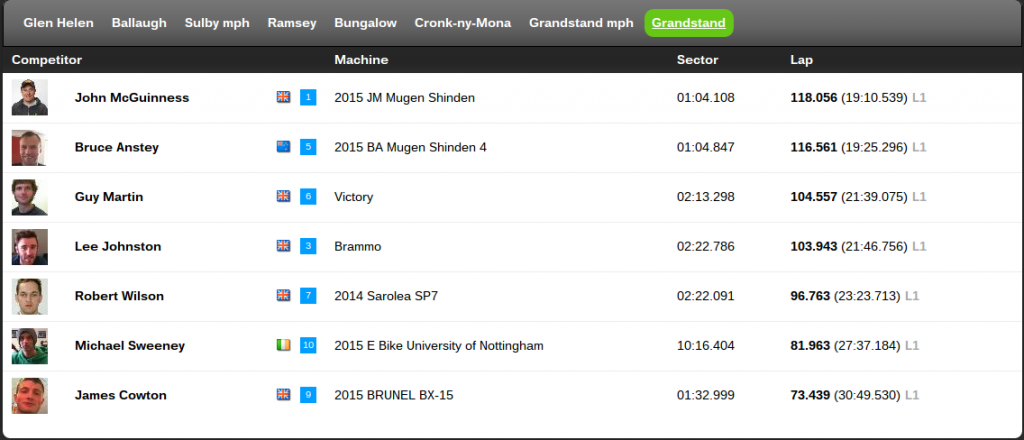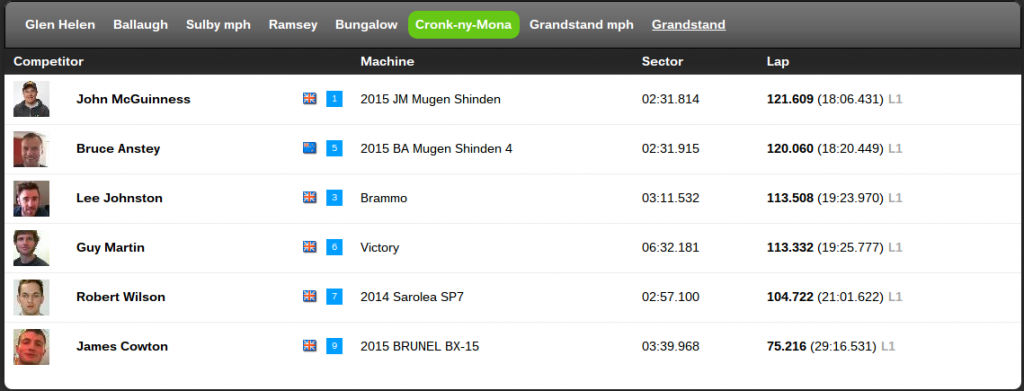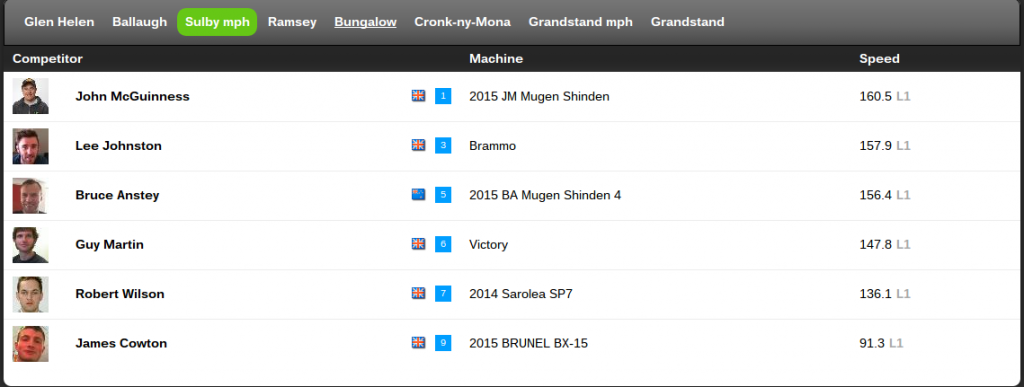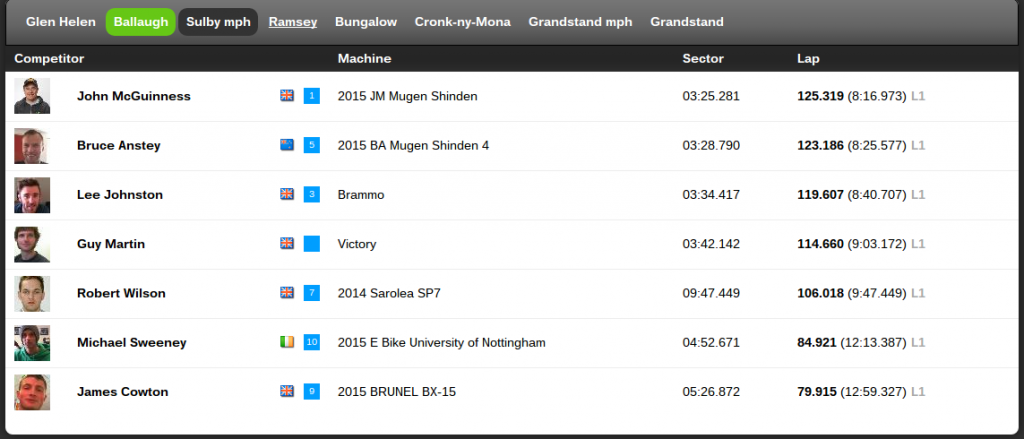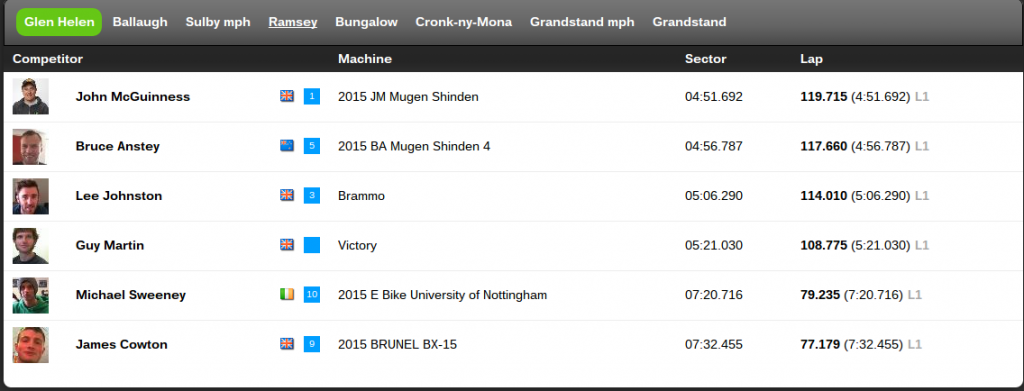Today, in the first qualifying round for the 2015 TT ZERO, John McGuinness unofficially broke the TT ZERO lap record with a 118.056 miles/hr lap speed. He of course set the official lap record last year at about 117 miles/hr riding the 2015 Mugen Shinden electric motorcycle. Given that his lap speed at Cronk-ny-Mona (and Bruce Anstey’s as well) was over 120 miles/hr, it looks like the 120 miles/hr lap speed threshold really will be broken in the 2015 TT ZERO electric motorcycle race.
To put some perspective on this – in the TT Sidecar race held about an hour earlier, the winning lap speed was 115 miles/hr with a half dozen just behind them at over 110 miles/hr. And the TT ZERO speeds were practically identical to the Lightweight qualifying round held immediately before. As this fellow on Twitter says, the electric bikes have the speed now to make for good racing action, the next goal is enough range for more than one lap.
https://twitter.com/MattBurton_law/status/607928513820270592
McGuinness’ new record is unofficial because it didn’t occur during a race, just during practice/qualifying.
Anyway, let’s get back to the results. As you see below, seven bikes qualified today. Of the eight bikes known to be at the 2015 TT ZERO, that leaves just the Kingston Univ bike to qualify. Qualification means the bike must take a complete lap in less than 45 minutes.
The two Mugen Shinden bikes of course are at the top of the results. The two Victory Motorcycles bikes (BTW – one is labeled “Brammo” .. sigh) gave a great result for their first time out. Going by the Sulby speed, these four are within grasp of each other.
However, Lee Johnston clearly ran low on battery power at the end of the lap. I’ve just watched a pair of videos posted on Facebook (that permissions don’t allow a repost here), one showing John McGuinness zipping by Cronk-ny-Mona at full speed and the other Lee Johnston crawling up the same hill and having to hop off the bike and push it get over the crest of the hill. That tells us the two Victory bikes ran into battery capacity limits and therefore came in slower than the two Mugen bikes, even though all four showed similar speeds at Sulby.
Guy Martin is riding for Victory Motorcycles instead of William Dunlop, because Dunlop was injured earlier in a practice session. According to a BBC report, Dunlop may have suffered broken ribs and may be out of the action for the rest of the event.
Qualifying is a big achievement for the Nottingham team, as their bike was unfinished when they arrived on the Island. I’m sure they pulled an all-nighter or two to get to that point. According to a comment on Facebook, the team had turned the wick down because this was the bike’s maiden voyage. They’re expecting to hit a 100+ miles/hr lap speed for the race.
The planned TT ZERO schedule was to have qualifying races on Saturday and Sunday following the practice round on Friday. However, windy weather on Saturday forced cancellation of all racing activities that day, making this the first TT ZERO activity since Friday.
There’s another TT ZERO qualifying round on Tuesday, and the race is scheduled for Wednesday morning.
After Friday’s practice round, Victory Motorcycles sent out a press release talking about their achievement of having both bikes finish a lap at over 100 miles/hr, hence becoming the third team to reach that accomplishment. The press release clarified Brian Wisman’s role – he’s the Victory Racing team manager, and head of product development for Brammo Power. It also contained some details on the bikes:
TECHNICAL INSIGHTS
Following these promising results, Victory Racing has also revealed more technical insights in to the electric bikes.
The bike has two Brammo batteries that sit on top of one another and they actually form part of the bike’s structure. These batteries sit between a twin-spar aluminium frame with Ohlins suspension connecting the swingarm to the top of the batteries. While Brammo has created the batteries, the electric motor is made by Parker, joining Victory Racing’s TT effort under the name of Parker Racing.
The configuration of the Parker GVM motor and the swingarm is unique too. On conventional petrol-fuelled bikes the swingarm pivot point is behind the engine, but on these electric bikes, the swingarm pivot point is in front of the motor. The bikes have chains and sprockets, but the chain is set tighter than on conventional motorcycles because there is so much torque from the Parker GVM motor.
The wheels are forged magnesium, made by OZ Racing and mounted onto Ohlins forks with World Superbike-spec Brembo brakes. The rider’s display is a Motech ADL3, which also records all of the data from the electrical system.
Victory Racing has also announced that the bikes have an in-built energy recovery system, with the rate of this recovery configurable. Interestingly, Lee likes to run his recovery setting some 30% less than William’s. As Brian Wismann explains: “This is all down to riding style and how each rider prefers to get the chassis set for the entry to the corner. William prefers the regenerative braking to be higher to help slow his entry speed.”
Victory Racing has also announced that the electric bike has actually been developed for short circuit racing, so the longer 37-mile length of the TT course poses a greater challenge for setting the bike up for the race. While there are the two Brammo batteries linked to the Parker GVM electric motor, extra ‘boost modules’ can be added or taken away from the bike. Brian explains: “Here at the TT we are running the highest number of boost modules that we can carry. With these on board we can make 165bhp at the rear wheel. The bike in its TT configuration weighs around 220kg, but in its short circuit configuration drops to 209kg.”
Part of the challenge, says Brian Wismann, is to get the maximum amount of power from the batteries and boost modules while making sure the bike has enough electrical energy to get around the course.
- Is there enough Grid Capacity for Hydrogen Fuel Cell or Battery Electric cars? - April 23, 2023
- Is Tesla finagling to grab federal NEVI dollars for Supercharger network? - November 15, 2022
- Tesla announces the North American Charging Standard charging connector - November 11, 2022
- Lightning Motorcycles adopts Silicon battery, 5 minute charge time gives 135 miles range - November 9, 2022
- Tesla Autopilot under US Dept of Transportation scrutiny - June 13, 2022
- Spectacular CNG bus fire misrepresented as EV bus fire - April 21, 2022
- Moldova, Ukraine, Georgia, Russia, and the European Energy Crisis - December 21, 2021
- Li-Bridge leading the USA across lithium battery chasm - October 29, 2021
- USA increasing domestic lithium battery research and manufacturing - October 28, 2021
- Electrify America building USA/Canada-wide EV charging network - October 27, 2021







